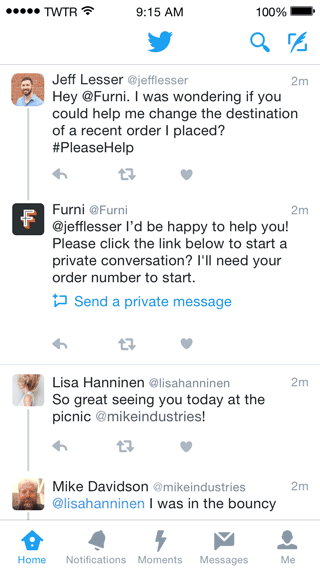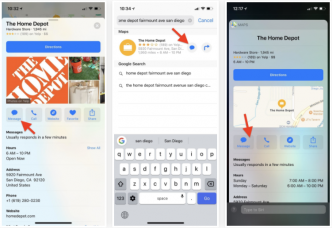Last week, Facebook announced that WhatsApp could now be used as a customer service platform. We now have an interesting race between Apple’s “Apple Business Chat”, Facebook’s own “Messenger for Business”, and Twitter. The goal is to grab a vital piece of the eCommerce landscape: The channel for customer service communication.
What caught my eye is that WhatsApp is asking companies to pay in order to use its platform for customer service. Twitter quietly made this move a few months ago, too. What does it mean? Are these fee structures really there to earn revenue or to incent certain behavior? Will Apple follow suit?
 WhatsApp
WhatsApp
The WhatsApp announcement got a huge amount of press last week. But many people didn’t pick up on the fee issue. From Forbes:
“WhatsApp says that businesses can send messages to WhatsApp users for free within 24 hours of initiating a chat. After 24 hours, businesses ‘will pay to send certain messages.’”
An industry executive that’s working with WhatsApp told me that messages sent after the 24-hour window have to conform to one of several templates, pre-approved by WhatsApp.
Forbes continues: “This is part of a broader effort by Facebook to monetize WhatsApp, which had been making nominal revenues from annual subscription fees…”
I’m guessing Forbes is wrong on that and this is less about monetizing WhatsApp and more about avoiding spam and abuse by companies.
Twitter has had an odd relationship with customer service. For the first few years of its existence, the company paid no official attention to the fact that it had become de facto place for consumers and businesses to interact. They never intended that to be the role of their platform. But the fact that all tweets are public and searchable meant that companies were forced into responding to tweets for fear of looking unresponsive in front of the whole world.

Starting around 2014, it embraced this role whole heartedly, publishing a comprehensive Customer Service Playbook. But then, Twitter had a bit of an identity crisis: Is it a media company? A news company? A general purpose messaging platform? See Dear New Owners of Twitter: Don’t Screw Up This One Thing, Please and The Secret Behind Twitter’s Customer Service Superpower.
Today, there is a whole section of their site devoted to using the platform for customer service. But new pricing coming out this month may make it harder for Twitter to continue this path. In this case, it’s hard to say what behavior they’re trying to encourage or prevent because the pricing is not disclosed
Apple
A central challenge in getting consumers to use chat for customer service is the “discovery problem”. How do you know if a particular company will be responsive on a particular channel? Apple has a unique strength on this front because they can provide onboarding points throughout the iOS experience. You can see below how Business Chat appears via Maps, Safari or Search. This tight integration is something only they can do. For more see Apple Business Chat: Strengths and Weaknesses.
Apple is not charging businesses or the intermediary “customer service platforms” for the use of Apple Business Chat. They only make money if Apple Pay is used. Might this change? Well, they’re not hurting for revenue, what with being the first trillion dollar company and all.
But they do have opinions about how chat should work, and it’s conceivable that they will use pricing signals to enforce that. For example, they’ve emphasized that Business Chat is about human-to-human communication and not about “bots” (a contrast with Facebook Messenger, where its role as a bot platform received a huge amount of attention, followed by a backlash.) And, there’s this, from the Apple Business Chat page: “Talk to a real person … Most often, your conversations will be with a live agent. You might get a fast, automated response for simple requests, but a real person will be available if needed.”
How serious is that promise that “a real person will be available”? How will Apple enforce this? A time-window pricing structure like WhatsApp’s? Customer reviews, similar to the App Store? For more on this, read What if Customer Service Worked Like the App Store?
Big Picture
Let’s zoom out. All of these messaging channels are competing against the SMS channel (owned by no one) and web-based chat (offered by dozens of vendors). And, of course, they’re all competing against the good ‘ole phone channel (which refuses to ride off into the sunset, contrary to many predictions). See Is Chat Eating into Phone-Based Customer Service?
Wait, let’s zoom out even more. All of those channels (SMS, messaging, web-based chat and the phone) are forms of human-assisted service. Collectively, they are all in tension with the universe of self-serve options. It’s a truism in the call center world that this years’ hot technology will be lauded as the one to “kill the call center”. That’s always good for a chuckle. (For more on this tension, check out What’s the Ceiling on Self-Service?)
The point is there are a lot of moving parts here, which is why customer service technology continues to be a really fascinating sector

The Secret Sauce for Customer Happiness
Learn the key ingredients for making customer happiness the forefront of every business interaction.
